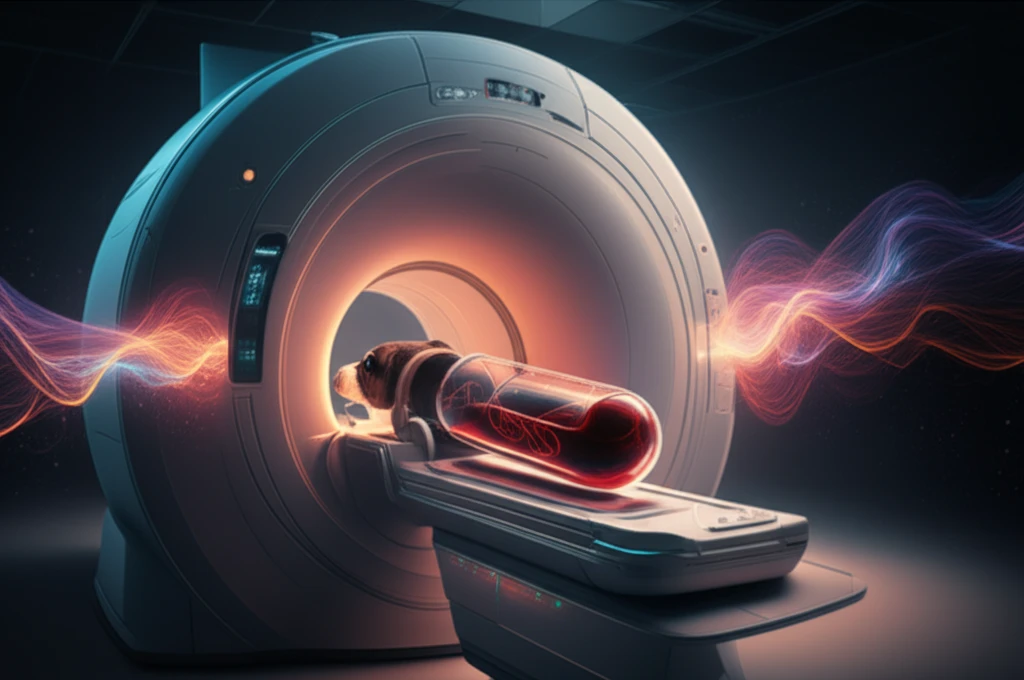
Decoding Dog Blood: What Low-Field MRI Reveals About Canine Health
"An in-depth look at how low-field MRI technology is enhancing the diagnosis of canine conditions through blood analysis, exploring its potential and limitations."
Low-field magnetic resonance imaging (MRI) is increasingly valuable in veterinary medicine, particularly for imaging the central nervous system, including the brain and spine. While higher field strength MRIs are becoming more common in academic settings, low-field MRI remains a staple in veterinary practices due to its cost-effectiveness. However, this lower cost comes with reduced specifications, making it challenging to differentiate specific lesions, such as hemorrhages, within intracerebral and epidural spaces.
The appearance of hemorrhage in MRI scans can vary significantly based on factors like the age of the blood. Accurate diagnosis of intracranial and epidural hemorrhages is challenging, especially with low-field MRI. Both intrinsic factors, such as the time since the bleeding started, and extrinsic factors, like the pulse sequence and field strength used, influence the MRI signal intensity of a hemorrhage.
Recognizing the need for better understanding, a study was conducted to assess time-sensitive magnetic resonance (MR) changes in canine blood using low-field MR. This article delves into the findings of that study, exploring how canine blood changes over time in MRI scans and what these changes can tell us about a dog's health.
Unlocking Insights: How Canine Blood Changes Appear on Low-Field MRI

The study involved collecting arterial and venous blood samples from eight healthy beagle dogs. These samples were then placed in tubes and imaged at regular intervals over 30 days using various MRI sequences, including T1-weighted (T1W), T2-weighted (T2W), fluid-attenuated inversion recovery (FLAIR), short tau inversion recovery (STIR), and T2-star gradient-echo (T2-GRE).
- T1-weighted (T1W): Shows detailed anatomical structures, with fat appearing bright and water appearing dark.
- T2-weighted (T2W): Highlights areas with high water content, making fluids appear bright.
- Fluid-Attenuated Inversion Recovery (FLAIR): Suppresses fluid signals, making it easier to detect lesions near fluid-filled spaces.
- Short Tau Inversion Recovery (STIR): Highly sensitive to fluid and inflammation, with fat signals suppressed.
- T2-star Gradient-Echo (T2-GRE): Sensitive to magnetic field distortions, useful for detecting blood products and hemorrhages.
Navigating the Future: What These Findings Mean for Canine Care
This study highlights the intricacies of using low-field MRI to assess canine blood characteristics and diagnose related conditions. The complex changes observed in blood clots over time indicate that relying solely on low-field MRI for accurate hemorrhage characterization and clot age prediction may be challenging.
Veterinarians and researchers can use these findings to better understand the limitations and potential of low-field MRI in diagnosing canine health issues. By recognizing the specific signal changes and their timelines, clinicians can improve their interpretation of MRI scans and integrate this information with other diagnostic tools for more accurate assessments.
Further in vivo studies are essential to fully explore the chronological low-field MR signal intensity changes in hemorrhages. These future investigations could refine diagnostic protocols, enhancing the ability to detect and manage various conditions affecting canine health. With continued research, low-field MRI can become an even more valuable asset in veterinary medicine, aiding in more precise and timely interventions.
